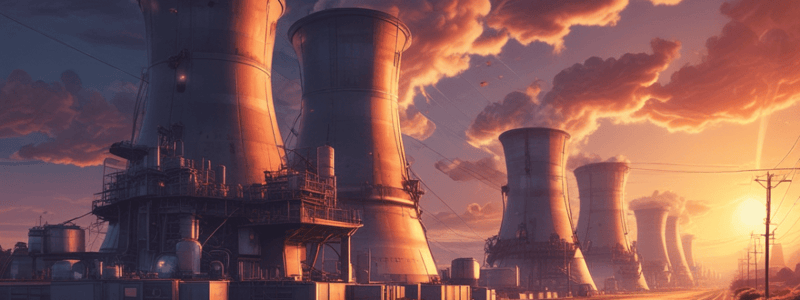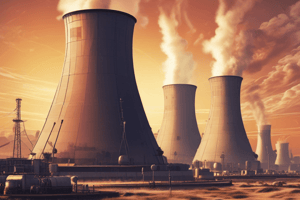Podcast
Questions and Answers
What is the most common source of electricity produced from nuclear power plants?
What is the most common source of electricity produced from nuclear power plants?
- Uranium
- Steam
- Electricity (correct)
- Heat
What is the approximate percentage of the world's electricity that is generated by nuclear power plants?
What is the approximate percentage of the world's electricity that is generated by nuclear power plants?
- 1%
- 10% (correct)
- 25%
- 5%
What does the term 'mass defect' refer to in the context of nuclear energy?
What does the term 'mass defect' refer to in the context of nuclear energy?
- The increase in mass that occurs when atoms are fused together.
- The amount of mass that is lost due to radioactive decay.
- The loss of mass during a nuclear reaction, which is converted into energy. (correct)
- The difference in mass between the reactants and products of a chemical reaction.
What is a significant environmental benefit of nuclear energy compared to fossil fuels?
What is a significant environmental benefit of nuclear energy compared to fossil fuels?
How does nuclear energy compare to traditional energy sources like coal and oil in terms of the amount of energy produced per unit of fuel?
How does nuclear energy compare to traditional energy sources like coal and oil in terms of the amount of energy produced per unit of fuel?
What is a major drawback of nuclear energy, despite its benefits?
What is a major drawback of nuclear energy, despite its benefits?
What is one real-world application of nuclear energy besides power generation?
What is one real-world application of nuclear energy besides power generation?
Which of the following is NOT a key step in the process of generating electricity from a nuclear power plant?
Which of the following is NOT a key step in the process of generating electricity from a nuclear power plant?
What is the definition of energy?
What is the definition of energy?
What type of energy is released during chemical reactions?
What type of energy is released during chemical reactions?
What is an example of nuclear fission?
What is an example of nuclear fission?
What is the result of nuclear fission and fusion?
What is the result of nuclear fission and fusion?
What is the purpose of nuclear power plants?
What is the purpose of nuclear power plants?
How many reactors are powered by nuclear energy across the world?
How many reactors are powered by nuclear energy across the world?
How does nuclear energy fundamentally differ from chemical energy?
How does nuclear energy fundamentally differ from chemical energy?
What is the primary difference between nuclear fission and nuclear fusion?
What is the primary difference between nuclear fission and nuclear fusion?
Which of the following is an example of nuclear fission?
Which of the following is an example of nuclear fission?
What is the primary function of a nuclear power plant?
What is the primary function of a nuclear power plant?
In what ways has nuclear energy impacted global society?
In what ways has nuclear energy impacted global society?
What does the statement 'matter being converted into energy' refer to in the context of nuclear reactions?
What does the statement 'matter being converted into energy' refer to in the context of nuclear reactions?
What is the process called when two hydrogen atoms combine to form a larger atom with two protons and two neutrons?
What is the process called when two hydrogen atoms combine to form a larger atom with two protons and two neutrons?
What is the typical atom used in the process of nuclear fission?
What is the typical atom used in the process of nuclear fission?
What is the result of the mass defect in nuclear fusion?
What is the result of the mass defect in nuclear fusion?
What is the purpose of the water in a nuclear reactor core?
What is the purpose of the water in a nuclear reactor core?
What is a major drawback of nuclear fission?
What is a major drawback of nuclear fission?
What is a common application of nuclear fusion in the natural world?
What is a common application of nuclear fusion in the natural world?
What fundamental concept associated with mass and energy was introduced by Albert Einstein in 1905?
What fundamental concept associated with mass and energy was introduced by Albert Einstein in 1905?
How much energy can a single fuel pellet of uranium produce compared to fossil fuels?
How much energy can a single fuel pellet of uranium produce compared to fossil fuels?
What is one major advantage of using nuclear energy as a power source?
What is one major advantage of using nuclear energy as a power source?
What is a significant disadvantage associated with nuclear energy production?
What is a significant disadvantage associated with nuclear energy production?
In the context of nuclear reactions, what happens to mass during the reaction?
In the context of nuclear reactions, what happens to mass during the reaction?
In what application is nuclear energy used besides electricity generation?
In what application is nuclear energy used besides electricity generation?
What factor indicates the efficiency of nuclear power in energy production?
What factor indicates the efficiency of nuclear power in energy production?
What is a real-world benefit of using nuclear energy in the context of climate change?
What is a real-world benefit of using nuclear energy in the context of climate change?
Flashcards are hidden until you start studying
Study Notes
Definition of Nuclear Energy
- Energy is the power to perform work or exert force, generated through chemical or nuclear processes.
- Nuclear energy is released from the nucleus of atoms, fundamentally altering the atom's structure.
Production of Nuclear Energy
- Nuclear energy is produced via nuclear fission (splitting large nuclei) or nuclear fusion (fusing small nuclei).
- Fission transforms elements, e.g., uranium into plutonium, releasing vast amounts of energy.
- Nuclear power is utilized in power plants to supply electricity across the globe.
Types of Nuclear Reactions
- Nuclear Fission: Splitting of uranium atoms (most massive naturally occuring element) releases energy due to the mass defect.
- Nuclear Fusion: Fusing hydrogen atoms forms helium, releasing energy; processes like these power the Sun.
Nuclear Fusion
- Involves combining hydrogen atoms to produce helium, resulting in an energy release due to mass loss.
- Commonly occurs in nature, notably in stars and the Sun, and contributes to renewable energy sources like solar and wind.
Nuclear Fission
- Involves bombarding uranium, causing it to become unstable and split, which releases energy.
- Used in nuclear power plants and weapons, highlighting the challenges of controlling such reactions.
- Byproducts of fission can be radioactive for millennia, creating disposal challenges.
Atomic Energy and Control
- Fission reactions in power plants are regulated, while weapons induce uncontrolled chain reactions.
- Byproducts of fission are often unstable isotopes that emit harmful radiation as they decay.
Nuclear Power Plants
- Facilities that convert nuclear energy into electricity using a controlled fission reaction.
- The first power plant, EBR-I, operated in 1951, generating minimal power but demonstrating the technology.
- Currently, there are 445 active nuclear power plants globally, producing around 10% of the world's electricity.
Operation of Nuclear Power Plants
- Use uranium pellets in fuel rods, which are submerged in water to regulate the reaction and produce steam.
- Steam drives turbines connected to generators, creating electricity.
Importance of Nuclear Energy
- Mass-energy equivalence, described by Einstein's equation, illustrates the energy produced from small masses during nuclear reactions.
- One uraniam fuel pellet can generate energy equivalent to 2,000 pounds of coal or 149 gallons of oil.
Real-World Applications
- Provides substantial energy output helping fight climate change but creates challenges with radioactive waste management.
- Used to power submarines and space probes.
- In nuclear medicine, radioactive isotopes assist in medical imaging for diagnostics.
Summary
- Nuclear energy is a powerful, non-carbon energy source with significant implications for global energy needs and challenges related to waste and safety.
Definition of Nuclear Energy
- Energy is the power to perform work or exert force, generated through chemical or nuclear processes.
- Nuclear energy is released from the nucleus of atoms, fundamentally altering the atom's structure.
Production of Nuclear Energy
- Nuclear energy is produced via nuclear fission (splitting large nuclei) or nuclear fusion (fusing small nuclei).
- Fission transforms elements, e.g., uranium into plutonium, releasing vast amounts of energy.
- Nuclear power is utilized in power plants to supply electricity across the globe.
Types of Nuclear Reactions
- Nuclear Fission: Splitting of uranium atoms (most massive naturally occuring element) releases energy due to the mass defect.
- Nuclear Fusion: Fusing hydrogen atoms forms helium, releasing energy; processes like these power the Sun.
Nuclear Fusion
- Involves combining hydrogen atoms to produce helium, resulting in an energy release due to mass loss.
- Commonly occurs in nature, notably in stars and the Sun, and contributes to renewable energy sources like solar and wind.
Nuclear Fission
- Involves bombarding uranium, causing it to become unstable and split, which releases energy.
- Used in nuclear power plants and weapons, highlighting the challenges of controlling such reactions.
- Byproducts of fission can be radioactive for millennia, creating disposal challenges.
Atomic Energy and Control
- Fission reactions in power plants are regulated, while weapons induce uncontrolled chain reactions.
- Byproducts of fission are often unstable isotopes that emit harmful radiation as they decay.
Nuclear Power Plants
- Facilities that convert nuclear energy into electricity using a controlled fission reaction.
- The first power plant, EBR-I, operated in 1951, generating minimal power but demonstrating the technology.
- Currently, there are 445 active nuclear power plants globally, producing around 10% of the world's electricity.
Operation of Nuclear Power Plants
- Use uranium pellets in fuel rods, which are submerged in water to regulate the reaction and produce steam.
- Steam drives turbines connected to generators, creating electricity.
Importance of Nuclear Energy
- Mass-energy equivalence, described by Einstein's equation, illustrates the energy produced from small masses during nuclear reactions.
- One uraniam fuel pellet can generate energy equivalent to 2,000 pounds of coal or 149 gallons of oil.
Real-World Applications
- Provides substantial energy output helping fight climate change but creates challenges with radioactive waste management.
- Used to power submarines and space probes.
- In nuclear medicine, radioactive isotopes assist in medical imaging for diagnostics.
Summary
- Nuclear energy is a powerful, non-carbon energy source with significant implications for global energy needs and challenges related to waste and safety.
Studying That Suits You
Use AI to generate personalized quizzes and flashcards to suit your learning preferences.




